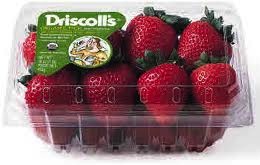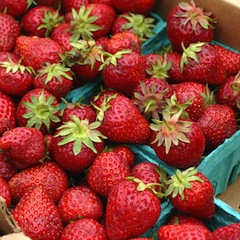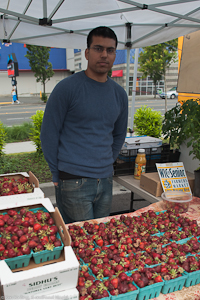 Every spring we’re seduced into buying one – just one – box of strawberries at the supermarket. They always look so beautiful: large berries, bright red, the leaves still attached and fresh…
Every spring we’re seduced into buying one – just one – box of strawberries at the supermarket. They always look so beautiful: large berries, bright red, the leaves still attached and fresh…
I imagine all kinds of wonderful treats made with them but first I just want to slice them up with a little honey and have them with yogurt. Silly me!
Open the plastic clamshell that displays those berries in all their voluptuousness; like Botticelli’s Venus on the seashell. Hold that little beauty in your palm – OK, stop salivating! Make that first slice right through the center…
Oops… when did ripe strawberries have white centers? Where’s that wonderful strawberry smell? And the taste? Cardboard has more taste!

Major commercial strawberry production in California began in the early 1850s but did not expand until around 1900, when refrigerated railroad cars enabled growers to transport the berries over long distances. Today strawberries are grown on more than 45,000 acres and the US is the world’s top producer of strawberries. And it’s the refrigeration that makes it possible for us to have strawberries almost year ’round.(1)
Weeds, insect pests, and disease can make commercial production of strawberries challenging; to prevent crop loss growers apply a variety of pesticides: herbicides, insecticides, and fungicides. It’s that use of pesticides that gives strawberries the #3 post on the Environmental Working Group’s Dirty Dozen list of fruits and vegetables. As many as 13 different pesticides were detected on a single sample of strawberries.
Just last December, under pressure from high-powered pesticide industry lobbyists, the California Department of Pesticide Regulation approved the use of methyl iodide – a potent carcinogen and water contaminant – on the state’s strawberry fields.

Even with all the pressure from conventional growers and the pesticide industry, it’s clear that organic is not only “as good as” conventionally grown, but is better over all. Recent research from Washington State University(2) compared side by side plots of organic and conventional strawberries in California. The results:
- Organic strawberries had more dry matter, or, “more strawberry in the strawberry.”
- Organic strawberries had significantly higher antioxidant activity and concentrations of ascorbic acid and phenolic compounds.
- Organic strawberries had longer shelf life.
- The organic soils excelled in a variety of key chemical and biological properties, including carbon sequestration, nitrogen, microbial biomass, enzyme activities, and micronutrients.
- The organically managed soils had dramatically more total and unique genes and greater genetic diversity, important measures of the soil’s resilience to stress and ability to carry out essential processes.
So where do you get fresh strawberries with flavor? Buy organic and buy local. Head out to your local farmers market and run – don’t walk – to the nearest berry vendor and buy organic or transitional berries.
They may not be “perfect,” some may be larger, some smaller, and occasionally even lumpy, but they are definitely REAL strawberries! And there’s nothing more heavenly than fresh ripe strawberries picked just hours before you buy them!
________________________________________
Resources:
(1) Agricultural Alternatives, Pennsylvania State University, Cooperative Extension
(2) Fruit and soil quality of organic and conventional strawberry agroecosystems, University of Washington, September 2010
Photo credit: La Grande Farmers’ Market, used with permission under Creative Commons license.
